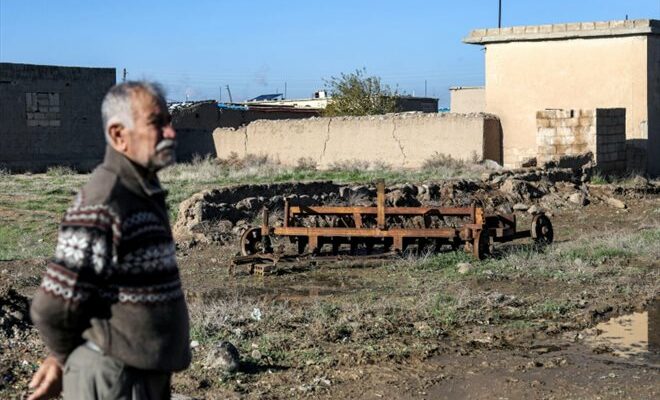Omar Abdel Fattah in his fields that he rents to another farmer, in Jaabar al-Saghir, July 11, 2023 in northern Syria (AFP/Delil SOULEIMAN)
In northern Syria, war and repeated droughts got the better of Omar Abdel Fattah, a farmer who abandoned his fields for a job that would allow him to support his family.
“I decided to work as an employee to provide for my family and guarantee an education for my children,” says this 50-year-old man with a weathered face.
In his village of Jaabar al-Saghir, near the town of Tabqa, located on the banks of the Euphrates which dries up from year to year, he shows his fields of wheat or cotton which he now rents to a another farmer.
“I can no longer bear the costs of agriculture, nor can I draw water from the Euphrates to irrigate the land,” adds this father of eight children.
“Seeing someone else cultivating my land breaks my heart,” he admits.

A shepherd leads a herd to pasture near a plot of agricultural land in the Qamichli region, December 14, 2023 in northeast Syria (AFP/Delil souleiman)
Mr. Abdel Fattah is now employed at a water pumping station under the Kurdish Autonomous Administration, which administers large areas of northeastern Syria. He receives a monthly salary of around $70.
“Some of my relatives have emigrated and others have rented their land because living conditions are very difficult,” he explains.
– “Little profits” –
The civil war in Syria, triggered in 2011 by the repression of pro-democracy demonstrations, has left more than half a million dead and divided the country into zones of influence.

A man works on agricultural land irrigated by groundwater from wells, on the outskirts of Qamishli, December 14, 2023 in northeast Syria (AFP/Delil souleiman)
In the dry plains around Tabqa and Raqqa, most of the fields are abandoned. In places, you can see a few farmers and workers harvesting potatoes and corn.
Desertification, reduced precipitation, drying up of rivers and extreme temperatures: in the region, the manifestations of climate change are omnipresent.
As a result, agricultural production in the country has declined by around 50% over the past ten years, according to Suhair Zaqout, spokesperson for the International Committee of the Red Cross for Syria.
Jassem al-Rached, a 55-year-old farmer from the village of Qahtaniya, near Raqqa, finds himself alone today cultivating his land, while his seven children helped him in the past.
“Two of them emigrated to Europe, two others became cattle traders and the last three joined the police and the Kurdish forces,” he said.
“Agriculture was my only source of income for thirty years”, but it is “no longer profitable (…) due to the drought”, he explains.
According to a World Weather Attribution (WWA) study, which analyzes the link between weather factors and climate change, published in November, high temperatures resulting from climate change have “increased the likelihood of a drought occurring in Syria by 25 times.” “.
Syria is one of the countries most seriously affected by climate change but receives the least funding to deal with it.

Farmer Farouk Mohamed in his fields in the Qamishli region, December 14, 2023 in northeast Syria (AFP/Delil souleiman)
In front of his now arid land near the Kurdish town of Qamichli, Farouk Mohamed also says he has decided to “work for the autonomous administration in order to make ends meet”.
“The region depends on rainwater. Years of drought have affected farmers, in addition to rising fuel prices,” explains the 40-year-old.
– “Desertification” –
Climate change is not the only problem. Syria, ravaged by civil war, is also gripped by a stifling economic crisis, marked by fuel shortages and long hours of electricity rationing.

Adnan Sabri, retired farmer, near his equipment and agricultural machines in the village of Kardim, December 14, 2023 in northeast Syria (AFP/Delil souleiman)
Farmers have difficulty irrigating their fields and purchasing the necessary fertilizers.
“Agriculture is in decline due to high costs, fertilizer prices, low rainfall and years of drought,” says Laïla Saroukhan, co-chair of the agriculture and irrigation authority within the Kurdish Autonomous Administration.
“Climate change is affecting precipitation rates and desertification is spreading in northeastern Syria,” she said, deploring “dangerous indicators for agriculture.”
Like many residents of northeast Syria, the children of Adnan Sabri, 56, left agriculture to join the Kurdish security forces, the “Asayish”, in order to have a fixed income.
In addition to the lack of water, “at any time, our fields could be bombed,” he says. “A job is more stable.”
© 2024 AFP
Did you like this article ? Share it with your friends using the buttons below.




